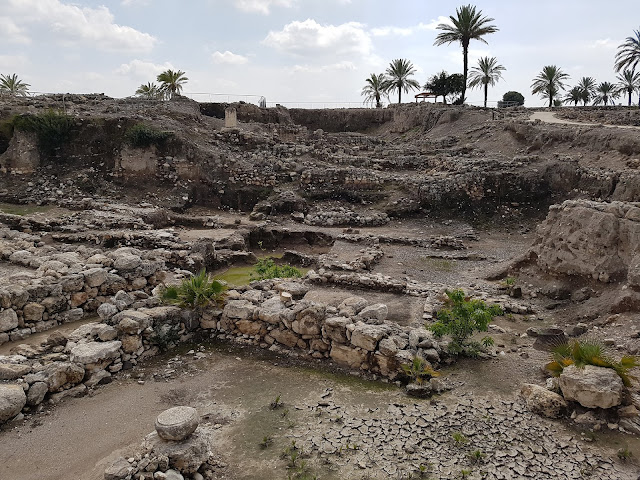Netanya to the Sea of Galilee
Tour day 1 - Thursday 28th March
We joined up with our tour group in Netanya last night for dinner, and discovered that we are, in fact, joining them rather than all starting out afresh. They have been together as a group for a couple of days already, visiting Jordan, and are now on the Israel leg of their trip. So we are the newbies. The group is almost 100% Americans and Canadians, apart from the 6.66% Australians. That would be us!! And our tour guide, Yakov, of course, who is a local. They are a friendly bunch, and we enjoyed getting to know a little about some of them over dinner.
This morning our wake up call was at 5.30am, groan! Breakfast was at 6.30am, then it was check out from the hotel and check luggage onto the bus at 7.15am before we set off around 7.30am. Not every morning will be like that, but there will be no sleeping in for the next couple of weeks, that’s for sure!!
Yakov taught us a couple of helpful phrases before we headed off - “boker tov” which means “good morning”, and the key word for today “savlalut” which means “patience”, something he advises we may need a good helping of as we navigate the various stops and other tour groups along the way!!
Our first stop is Caesarea Maritima, right on the Mediterranean, where we learned how Herod the Great brought his dream to fruition when he built this city and harbour around 25 - 13 BCE. We wandered among the ruins, marvelled at the remnants of ancient engineering, and stopped to listen to a group of Mennonite tourists singing the first verse and chorus of “How Great Thou Art” at the amphitheatre, to great applause from the onlookers.
A little further on we stopped to see the remains of the Roman-built aqueduct. It was mind-blowing to think that this amazing structure is still standing after more than 2000 years.
From Caesarea we travelled through the Wadi Milch (Arabic for “salt”) via the same Druze villages we stopped in to visit on Tuesday. According to Yakov, the Druze are very secretive about their beliefs, and they cannot marry outside their religion. They are very loyal to the land they are in, and these two villages in northern Israel are the southernmost places in the world where the Druze live.
We continued on to Mount Carmel (Carm-el = “God’s vineyard”) to see the same monastery we’d visited 2 days before. The contrast was stark - on Tuesday we’d almost had the place to ourselves. Today it was packed with tour groups, and hordes of children on school excursions. It made us super thankful that we’d already seen it, with time to explore in a leisurely way, and with a much clearer view from the upper level viewing platform. This time, however, it was good to hear our guide pointing out landmarks and giving some Biblical context to what we were seeing. See previous post for photos and more detail.
Tel Megiddo was our next stop, firstly for a falafel lunch, and then to explore this UNESCO World Heritage site. Our guide was a wealth of knowledge about the archeological mound and the many levels of civilisation that have been unearthed. He also informed us that the word “tel” actually refers to a hill created by layers of civilisation.
We saw a grain silo built in the time of King Jeroboam II, which would date it to around the 8th century BCE. Yakov also put into context several passages of scripture that relate to the HaMegiddo (Armageddon) battlefield. We then descended 187 steps into the 36 metre deep water system shaft, which was hewn out of the rock in the time of the Israelite kings in order to bring water to the city of Megiddo. Not for the faint-hearted or the claustrophobic! The whole place was amazing.
Not done yet, next it was through the fertile, green and very beautiful Jezreel Valley and on to Nazareth, perched high on a rocky hill, the home town of Jesus, where we spent a really enjoyable time being guided through the Nazareth Village, a recreation of Biblical times. The complex is a wonderful depiction of life as it would have been when Jesus was growing up. We met shepherds Abraham and Rebecca, Yusuf the techton (builder/architect/carpenter/stonemason), and Hannah the weavers, among others. All of these characters showed us how they would have worked at their craft in the time of Jesus.
Our guide for this part of the day, David, gave wonderful explanations of life in Jesus’ time, and made this visit thoroughly enjoyable. For me, the most mind-blowing moment was standing at the ancient wine-press, hewn out of the rocky hillside, and learning that since this spot was one of only 2 wine presses in the region, and very close to where the original village of Nazareth would have stood, it’s extremely likely that we were standing right where Jesus would have stood to participate in the treading of the grapes at some time in his young life. Hard to comprehend!
 |
| Ancient wine press close to original Nazareth |
From Nazareth we headed down the hill again, and across to the Sea of Galilee, where we are staying for 2 nights at a kibbutz called Ein Gev, right on the eastern shore of the lake. The weather was kind to us all day, and the Sea of Galilee greeted us with a soft dusk light. We are ready for an early night before another full day tomorrow.

















Comments
Post a Comment